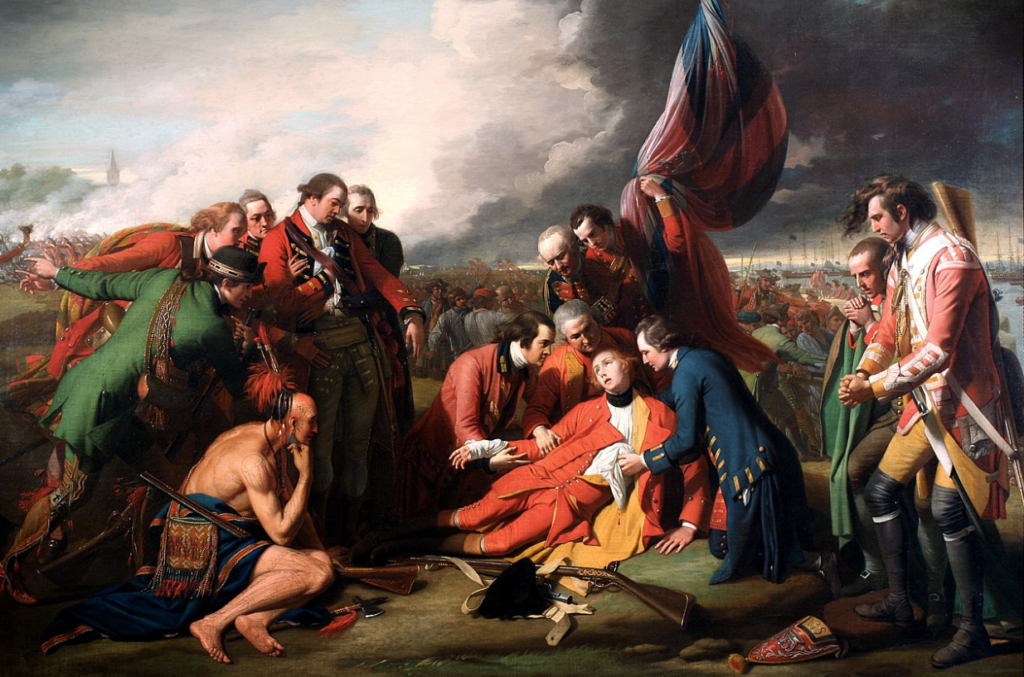Click photo for see more

The Death of General Wolfe (1770) is one of the most iconic paintings by the English artist Benjamin West. It depicts the death of British General James Wolfe during the pivotal Battle of Quebec in 1759, part of the larger Seven Years’ War. The battle was a decisive conflict between the British and the French for control over Canada. Wolfe’s death, though tragic, became a symbol of heroism and sacrifice, especially for the British forces.
Here’s a breakdown of the significance of the painting:
Historical Context:
- The Battle of Quebec: Wolfe led the British army during the battle, which took place on September 13, 1759, and was instrumental in the eventual British victory over the French in North America. Wolfe was fatally wounded during the battle but lived long enough to know of his victory. He died shortly after hearing that the French had surrendered.
- James Wolfe’s Legacy: Wolfe became a hero in Britain after his death. His bravery and the success at Quebec helped secure British dominance in North America, and he was celebrated as a martyr of the empire.
The Painting’s Composition:
- Dramatic Moment: West’s painting captures the very moment of Wolfe’s death, surrounded by his officers and soldiers. Wolfe is shown on the ground, bleeding from a wound in his chest, while his soldiers, including fellow officers, look on in a mixture of sorrow and admiration.
- Heroic Imagery: The image is imbued with a sense of stoic heroism. Wolfe is shown with an expression of calm, almost serene acceptance of his fate. His posture is dignified, with a sense of both pain and nobility in his death.
- Symbolism: Wolfe is depicted as a martyr-like figure. His death is shown as a selfless act for the greater good of Britain. The painting emphasizes the theme of sacrifice for one’s country, aligning with the heroic ideals of the time.
Style and Influences:
- Historical Painting: West’s work is a quintessential example of historical painting, which aimed to elevate real-life events to the level of mythic or classical heroism.
- Neoclassical Influence: The composition and dramatic treatment of the scene owe much to the neoclassical style, which sought to emulate the grandeur of ancient Roman and Greek art. The use of light, the pose of the central figure, and the surrounding figures all suggest a formal, almost ceremonial treatment of the subject.
- Emotional Impact: The painting goes beyond mere representation of an event. It is designed to evoke an emotional response, focusing on the tragedy of Wolfe’s death while also underscoring his glory and sacrifice.
Reception and Legacy:
- Popularity in Britain: The painting became immensely popular in Britain, where it was reproduced widely and helped cement Wolfe’s image as a national hero.
- Innovative Approach: West’s decision to depict a modern, historical event (rather than a classical or mythological one) was innovative for the time and set a precedent for future works of historical painting.
- National Symbol: The image of Wolfe’s death became a symbol of British sacrifice and victory during the period. It played a role in shaping national identity, particularly in the context of British colonial expansion.
Influence:
- Artistic Influence: West’s painting was groundbreaking in its approach, influencing future generations of artists who sought to capture historical moments with dramatic intensity.
- Popular Culture: The painting’s legacy endures, with various renditions and interpretations of the Battle of Quebec and Wolfe’s death still present in modern media.
In summary, The Death of General Wolfe is a key work in Western art history, combining dramatic realism with heroic idealism, while also cementing General Wolfe’s place in the pantheon of British national heroes. It remains one of the most famous depictions of a historical event in Western art.